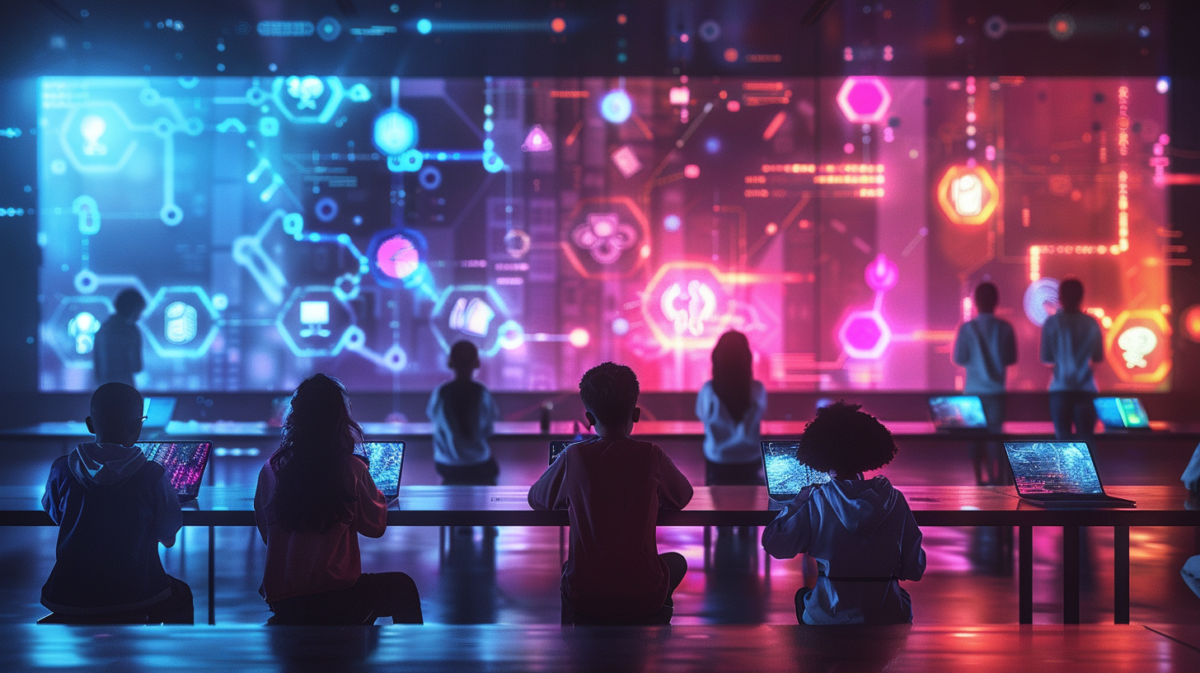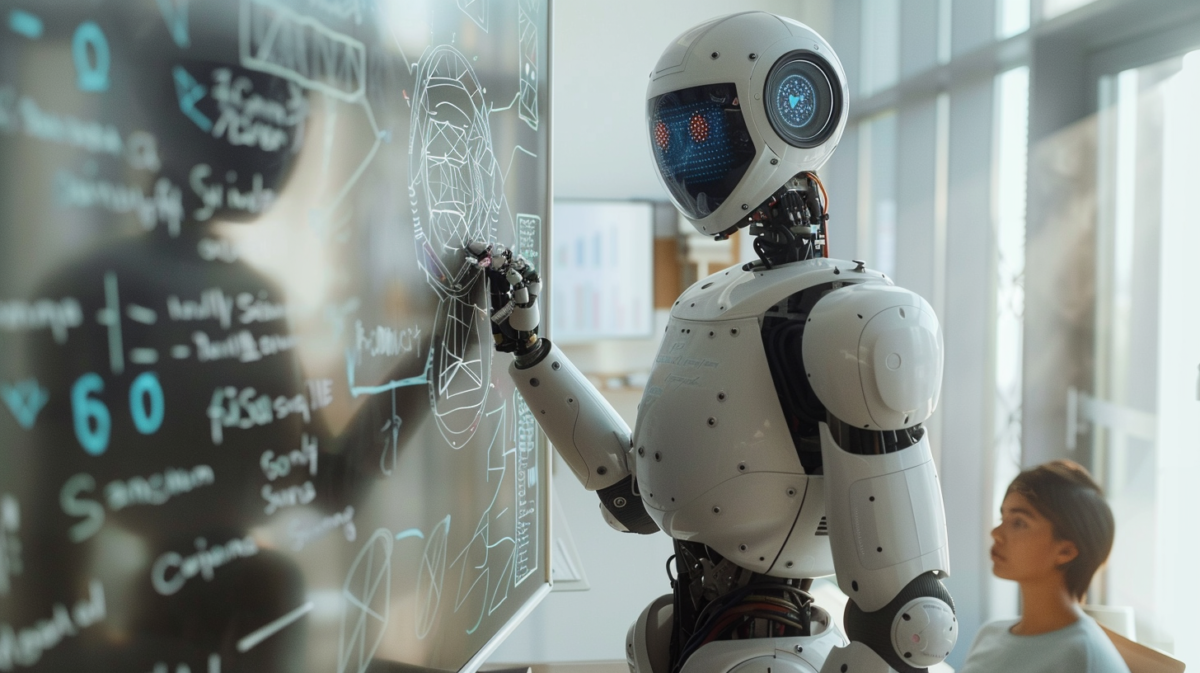
AI In Education: New Learning And Teaching Opportunities
Is AI The Best Assistant For Educators?
AI solutions in education are shifting learning to be more interactive and adaptive. At first, developers used AI for simple tasks like grading quizzes and scheduling classes. Currently, its role is expanding, showing its potential both in teaching and learning.
AI is becoming essential in the edtech domain because it meets the growing need for personalized learning. It excels at spotting trends in student data, letting teachers adjust lessons on the fly. This not only keeps students engaged but also improves their learning results.
Yet, using advanced AI chatbot solutions in schools comes with challenges. There are worries about how it handles private data and the ethical side of tracking student progress. There’s also the concern that too much tech might reduce the important personal touch teachers offer.
Despite these issues, AI is opening new possibilities in education. We’re looking into its main uses, benefits, and new trends while thinking about how it might alter the teacher’s role. AI is a valuable tool, but it brings up several issues that educators need to manage to enhance learning effectively.
Top Use Cases of AI in Education
Personalized Learning
AI adapts swiftly to each student’s individual pace and learning style. It provides customized resources and assignments, improving their educational outcomes. This tailored approach makes sure every student gets the attention they need. As a result, learning becomes more effective and engaging for everyone.
Automated Administrative Tasks
AI systems take care of everyday tasks like grading and tracking attendance. By doing this, they save teachers a lot of time. Teachers make fewer mistakes and have more time to concentrate on teaching. This means they can spend less time on paperwork and more time helping students learn. This shift lets teachers dedicate their energy to what really matters: educating their students.
Real-Time Feedback
AI education tools provide instant feedback on students’ assignments and quizzes. This quick response lets students immediately see their mistakes. Consequently, they learn from their errors more quickly and effectively. This process not only speeds up the learning process but also makes it more effective overall.
Enhancing Accessibility
AI tools are changing the game for students with disabilities by making learning materials easier to access. For example, text-to-speech features allow these students to hear their reading materials instead. Also, personalized learning adjustments tailor the educational content to meet each student’s unique needs. These innovations ensure that all students, regardless of their abilities, have a fair chance to succeed in their education. This approach fosters a more inclusive learning environment.
Intelligent Tutoring Systems
AI-driven onboarding and tutoring systems engage with students personally. They guide learners through difficult topics by asking questions that make them think, giving helpful hints, and explaining ideas in different ways. These systems adjust to each student’s unique pace of learning. They offer support precisely when the student needs it, making learning more effective and enjoyable.
Content Customization
AI evaluates what students know and what they like to then suggest personalized reading materials and resources. This approach makes sure that students receive content that suits their learning level and interests. As a result, students find the material engaging and form a stronger bond with what they learn. This method helps students enjoy their education more and connect with the content on a deeper level.
Virtual Reality Learning Environments
AI combined with VR technology creates engaging and interactive learning experiences. These virtual environments mimic real-life situations, allowing students to participate actively. By doing so, students can grasp concepts more effectively and remember information longer. This method makes learning enjoyable and effective, improving both engagement and knowledge retention
Language Learning
AI plays a vital role in helping students learn new languages. It corrects their pronunciation and offers grammar tips. Students can also practice speaking with conversational AI tools. These tools respond in real time, creating an engaging environment for students to improve their language skills. They get the chance to practice often, which makes their learning feel more natural and effective. This approach helps students become confident in using a new language.
Predictive Analytics
AI uses data from how students interact and perform to predict their future learning outcomes. With this insight, educators can more effectively customize their teaching strategies and interventions. This tailored approach helps each student learn better and faster. By adjusting their methods, teachers ensure that every student gets the support they need.
Early Warning Systems
AI systems examine how students are performing to spot those who might fall behind. Armed with this data, teachers can swiftly step in. They offer focused help to these students, ensuring they catch up and keep pace with their classmates. This proactive approach keeps everyone moving forward together.

Application Benefits of AI in Education
Increased Engagement
AI-powered roleplay chatbots make lessons interactive, which keeps students engaged and promotes active learning. For instance, gamified learning platforms use AI to adjust challenges to match each student’s skill level. This approach keeps students interested and helps avoid frustration. By doing this, students can learn at their own pace and feel more in control of their learning experience. This personalized method not only makes learning fun but also more effective.
Data-Driven Insights
AI studies large sets of educational data to give teachers clear insights. These insights show teachers which concepts students understand easily and which need more explanation. Consequently, teachers can tweak their teaching methods to fit the needs of their students better. This focused strategy ensures that education is as effective as possible, helping students learn more efficiently.
Scalability
AI-driven educational platforms can reach thousands of students at the same time. They deliver personalized content and assess student work effectively. This means every student gets access to quality educational resources. It doesn’t matter how large the class is or where students are located. Thus, AI helps ensure all learners receive the same level of education.
Support for Teachers
AI helps teachers by quickly analyzing how students are performing. This fast analysis shows where students need help, letting teachers step in right away. Teachers can then focus on these areas, providing learners with other activities. This process makes learning more effective and ensures that students get the support they need exactly when they need it
Consistent Quality of Education
AI consistently upholds strong educational standards in various environments and schools. It offers equal resources and teaching tools everywhere. This approach means that all students get a fair chance at a good education. Moreover, by distributing these tools universally, AI helps make sure every learner has the opportunity to succeed. This contributes to a more equitable educational system.
Time Efficiency
AI simplifies tasks that take a lot of time, like grading and making schedules. Because of this, teachers have more time to engage in interactive and creative teaching methods. Consequently, this improves the learning environment for both students and teachers. Teachers can focus on fostering creativity and deeper understanding in the classroom. This makes learning more enjoyable and effective for everyone involved.
Enhanced Accessibility
AI tools help students by providing learning materials in various formats. This meets the diverse needs of all learners, including those with disabilities. Features like speech-to-text, interactive textbooks, and personalized interfaces give every student the necessary tools for success. These technologies make it easier for students to access and engage with their coursework effectively.
Challenges of AI Integration into EdTech
Ethical Concerns
Questions about data privacy are a major concern. Educators and technologists are actively discussing the ethical side of using AI to monitor student activities. It’s important for schools to protect student information carefully. They also need to use AI in a responsible manner. This means making sure that they handle all data with great care to maintain trust and safety.
Dependence on Technology
Relying too much on AI consultants can cause a decline in classic teaching methods and reduce personal interactions between students and teachers. It’s essential for schools to find a good balance between using technology and maintaining human connections. This balance helps preserve valuable traditional skills and ensures that students still benefit from direct engagement with their teachers.
High Initial Costs
Implementing AI systems involves considerable costs initially. This expense can be a hurdle, particularly for smaller institutions or those with tight budgets. They may find it tough to adopt the latest technologies due to these financial challenges. However, understanding these barriers is the first step towards finding solutions that make AI more accessible to all educational entities.
Technical Limitations
AI sometimes struggles with the subtle aspects of human language and thought. This can lead to mistakes, especially in tasks such as essay grading. As a result, these limitations might make AI assessments less reliable. Therefore, it’s important to keep this in mind when using AI for important tasks.
Integration Complexity
Integrating AI into schools can be tricky. Often, schools must upgrade their systems and train their staff. This can disrupt their usual routines and require time. Moreover, these changes can lead to temporary challenges as everyone adjusts to the new technology. However, once in place, AI can greatly enhance the educational experience.

Emerging Trends of AI in Education
AI Tutors
Advanced AI tutors are gaining popularity. They help students learn outside of regular school hours. This flexibility allows students to study whenever it fits their schedule. These AI tutors are especially useful for those who need extra help or prefer to learn at their own pace. This makes learning more accessible and adaptable for everyone.
Predictive Analytics
Using AI to predict student outcomes is very helpful. It lets educators create better educational strategies. Additionally, it allows teachers to adjust their methods proactively. This proactive approach helps in tailoring lessons to meet the specific students’ needs.
Voice Assistants
Voice-activated AI agents play a key role in teaching. It supports learning in many languages. This makes education easier to access and more interesting for students from various backgrounds. Additionally, this technology helps everyone get the chance to learn in a way that suits them best.
Immersive Learning with VR
Virtual reality (VR) and AI work together to create engaging learning spaces. This technology mimics real-life situations, offering students a practical educational experience. Students can explore and interact with these scenarios as if they were actually there. This approach not only makes learning more interesting but also more effective.
Blockchain for Education
AI works together with blockchain to keep student records safe and transparent. This approach makes sure the data is accurate and makes managing records easier. Additionally, the use of blockchain means everyone can trust the system to be clear and honest without any confusion. This technology not only protects information but also streamlines the process of handling it.
Will AI Replace the Teacher?
AI is transforming how we teach, but it won’t replace teachers. The thing is, the teacher brings the crucial human touch that AI lacks, which is essential for motivating students and handling complex situations in the classroom. Additionally, teachers are key to the emotional and social growth of students. Meantime AI cannot fulfill this gap, so far (joke). Also, human educators help students overcome challenges, offer emotional support, and spark creativity.
Moreover, the deep perception and empathy teachers provide are something AI cannot match. While AI just delivers information and manages routine tasks, guidance and personal connection from teachers are indispensable for a complete educational experience. Thus, AI works best as a supportive tool that enhances, rather than replaces, the vital roles of teachers.
SoftBlues Agency – Your Advanced AI EdTech Developer
At SoftBlues, we develop top-notch AI solutions for edtech. We understand both technology and education deeply, allowing us to create tools that truly improve learning and administrative tasks. Also, we work closely with each client to ensure our technology meets their educational goals. We offer more than just software; we offer a partnership.
With our help, schools and universities can improve their educational services, keeping them ahead in educational innovation. We commit to ongoing improvement and customer satisfaction, helping institutions to achieve their tech goals. Rethinking the role of AI in education is not only about developing software solutions; it’s about trying to breathe life into new business ideas.
Are you ready to enhance your edtech business? Click below and talk to our AI assistant Lumia. Let’s work together to create something innovative!



